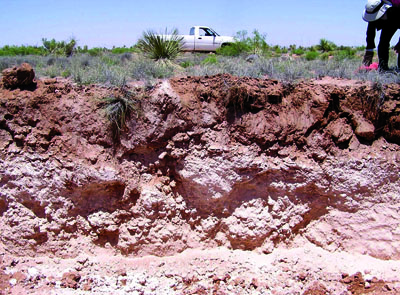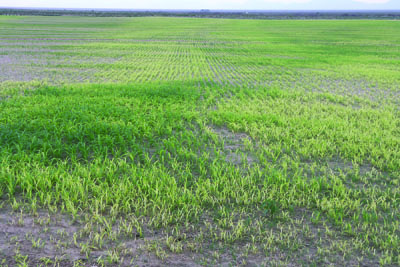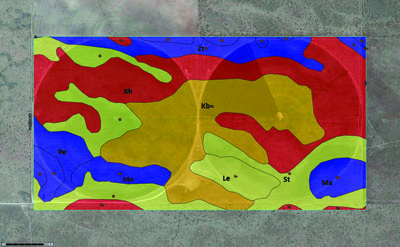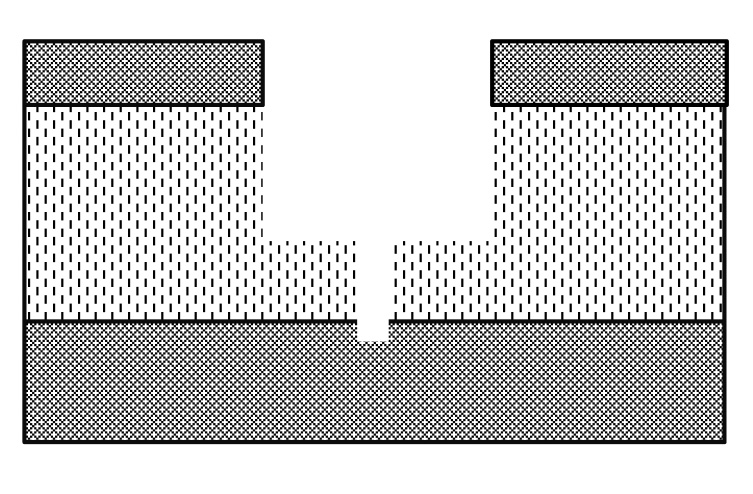Growing Plants in Caliche Soils
Guide A-151
John Idowu and Robert Flynn
College of Agricultural, Consumer and Environmental Sciences
Authors: Respectively, Extension Agronomists, Department of Extension Plant Sciences, New Mexico State University (Print Friendly PDF)
Introduction
Caliche is a whitish-gray or cream-colored soil layer that has been cemented by carbonates of calcium and magnesium. Caliche may occur as a soft, thin soil horizon (layer); a hard, thick bed; or a layer exposed to the surface by erosion (SSSA, 2001). Many soils of arid and semiarid regions, including New Mexico, have caliche layers (Figure 1) under the surface, and these layers may vary in thickness.

Figure 1. Caliche rock fragment from Tularosa, NM (photo by Robert Flynn).
Previous studies conducted in New Mexico show that caliche can have different physical properties, and different types of caliche layers can be found in the same field (Gile, 1961). For example, some caliche materials are very hard to break (strongly indurated or hardened; Figure 2) while some are relatively easy to break (slightly indurated; Figure 3).

Figure 2. Strongly indurated caliche layer found in Lea County (photo by Cheryl Kent).

Figure 3. Moderately indurated caliche layer found in Lea County (photo by Cheryl Kent).
The very hard caliche layers normally pose more problems for agricultural uses than those that are easy to break. Non-indurated caliche (sometimes referred to as “soft” caliche; Figure 4) does not pose a problem for root growth and development, but can impose some nutrient-related issues for crop growth because of pH and the presence of bicarbonates.

Figure 4. Non-indurated (“soft”) caliche can be found while soil sampling as white accretions usually below the first foot of soil in some locations (photo by Robert Flynn).
Caliche layers are formed when carbonates in the soil are dissolved and leached by rainwater. The water then rapidly evaporates or is removed by plants, leaving the carbonates behind. The carbonates bind with other soil particles (such as sand, clay, or silt) and become hardened caliche deposits (Hennessy et al., 1983).
When a caliche layer occurs in soil used for growing plants, severe limitations may occur that will hinder the performance of crops or trees. The greatest hindrance is posed when caliche occurs as a thick, very hard layer in the soil (moderately to strongly indurated). Under such a condition, caliche limits the growth of crops and trees primarily through root restriction, just like many other subsurface pressure-induced hard pans found in soils.
How Does Caliche Affect a Plant?
Caliche Affects Water Movement in the Soil
Depending on their thickness and physical nature, caliche layers can limit the flow of water into the deeper layers of the soil. Some studies have been conducted in semiarid southern New Mexico to understand the soil water dynamics of caliche materials. Hennessy et al. (1983) found that caliche rocks absorbed water rapidly and that the amount of water in caliche could be as high as 13% by weight, but this water is not easily released into the surrounding soil and is therefore unavailable for crop use. Although caliche can absorb considerable amounts of water, it does not allow water to flow through it rapidly, and a caliche layer prevents water from moving deeper into the soil profile. Therefore, crops that are growing in soils where a caliche layer is within the rooting zone may be susceptible to water stress due to inadequate moisture in the soil profile.
Caliche Layers Can Limit Crop Root Growth
When caliche is present in the soil as an indurated layer, it can physically restrict the growth of roots when present at shallow depths within the soil. Plant roots need to explore a considerable volume of soil to extract nutrients and water for growth and development. Any hard layer within the soil will limit the downward growth of roots and force them to grow laterally, and the plant will be unable to access the deeper soil layers. Thick and dense caliche layers will prevent effective rooting of both agricultural crops and trees, especially if they are present within the plant’s rooting depth.
Improperly Managed Caliche Soils Can Cause Accelerated Soil Erosion
Caliche layers can impede water movement into deeper soil layers, which tends to generate more runoff when there is high rainfall. If the rainfall rate is more than the soil can absorb, then runoff will occur, transporting soil particles away from the field and depositing them at offsite locations where they may not be desirable.
Caliche Can Affect Soil Nutrient Dynamics Due to High pH
Plants need soil nutrients for growth and development. Some of these soil nutrients are needed in large quantities and are called macronutrients, while others are needed in very small quantities and are called micronutrients (Baker et al., 1997; Flynn, 2012).
Although micronutrients are needed in very small quantities, micronutrient deficiencies can cause total crop failure, while high levels of soil micronutrients may even become toxic to plants (Baker et al., 1997; Flynn, 2012).
The availability of some micro- and macronutrients is sensitive to soil pH. Caliche layers are often found in calcareous soils with high pH ranging from 7.5–8.5. High-pH soils are notorious for limiting phosphorus availability to crops; phosphorus is chemically more available to crops when the soil pH is 6.0–7.0.
Some of the micronutrients that may be limited in soils with caliche are iron, boron, zinc, and manganese since the solubility of these nutrients is reduced at high pH. These nutrients need to be in soluble form for crops to absorb them. Figure 5 shows a sorghum × sudan showing symptoms of iron chlorosis in a caliche soil.

Figure 5. Sorghum × sudan growing in a caliche soil shows symptoms of iron chlorosis.
Depth to Petrocalcic (Caliche) Horizon
The amount of good soil above the petrocalcic horizon (caliche layer) can drastically limit crop production (Figure 6). The Web Soil Survey (USDA, 2013; http://websoilsurvey.nrcs.usda.gov can be used to estimate where depth to caliche (petrocalcic horizon) may limit crop growth (Figure 7). Soil series that have a shallow depth to caliche include the Kimbrough-Lea complex and Kimbrough loam.

Figure 6. Varying levels of green, yellow, and no growth due to a combination of high pH and depth to petrocalcic horizon.

Figure 7. Web Soil Survey (USDA, 2013) soil map highlighting soil series found within two selected center pivot irrigated fields in southeastern New Mexico containing soil series with shallow to deep depths to a petrocalcic horizon: Kimbrough loam (Kb) 16 inches, Kimbrough-Lea complex (Kh) 6 inches, Lea loam (Le) 26–40 inches, Mansker loam (Ma) >79 inches, Portales fine sandy loam (Pe) >79 inches, Stegall loam (St) 28 inches, Zita loam (Zt) >79 inches.
How Can We Manage Caliche Soils?
Managing soils with indurated caliche depends largely on the utility of the land. For commercial production, it is best to avoid using land with shallow caliche (<1 m below the surface) for crop production. As mentioned earlier, the cemented caliche pan will limit the rooting of crops, and there may be problems with waterlogging and lateral seepage of nutrients, which can lead to poor crop performance. However, if the indurated caliche is located at deeper soil layers, it is possible to successfully establish crops and trees.
The most important caution to exercise in all soils with caliche is to make sure that the surface of the soil is well protected. Without adequate vegetation on the soil surface, erosion by wind and water may occur, which will gradually reduce the soil depth and bring the caliche closer to the surface. Once the caliche becomes exposed to the surface, then the land becomes unsuitable for crop production.
Methods to Improve Caliche Soils
Break Through Indurated Caliche Layers
Since indurated caliche is like a pressure-induced hard layer within the soil that can impede water and root penetration, breaking this layer will help crops grow better and allow them to spread their roots into deeper soil horizons. Breaking the caliche layer is only possible is if is not so thick within the soil profile. Deep ripping or subsoiling can be considered if the field to be used is extensive, and the caliche layer is thin relative to ripping implements and not too hard. If the caliche layer is very thick, breaking the caliche pan becomes impracticable.
Dig a Hole Into the Caliche and Backfill with SoilFor establishing trees and shrubs over a small area, it is possible to dig holes into caliche layers and backfill with soil after removing the caliche fragments from the hole. The best option is to dig a hole through the entire caliche layer before backfilling with soil to ensure adequate drainage through the soil. However, if this is not possible, as in cases of thick caliche layers, then dig holes according to the recommended dimensions in Table 1.
|
Table 1. Suggested Hole Sizes to Dig Into Caliche for Establishing Different Plants |
|
|
Plant |
Hole Size |
|
Flower beds |
2 ft deep × 1/2 ft wide |
|
Small shrubs |
3 ft deep × 2 ft wide |
|
Large shrubs |
3 ft deep × 3 ft wide |
|
Small trees |
5 ft deep × 6 ft wide |
|
Large trees |
6 ft deep × 8 ft wide |
|
Source: Folkner (1956) |
|
The dimensions of the hole are proportional to the size of plant to be established. The hole should be large enough to ensure effective growth of plant roots. After digging to the required depth, if the caliche layer still continues beneath, dig a small drainage hole that penetrates through the rest of the caliche into the normal soil layer to allow adequate drainage (Figure 8.)

Figure 8. Excavation of caliche layer for plant establishment.
Use good-quality soil to backfill the hole in the caliche layer. A soil that has good levels of organic matter (2–4%) and that is neither too sandy nor too clayey will serve this purpose. You can send a sample of the soil to a soil testing laboratory to see if the soil will be able to supply the nutritional needs of the plant (refer to NMSU Extension Guide A-146, Appropriate Analyses for New Mexico Soils, https://pubs.nmsu.edu/_a/A146.pdf. If the soil has nutrient deficiencies, they can be corrected after backfilling. You can also mix compost or other organic amendments with the soil before backfilling. Usually a 1:4 ratio of low-salinity compost to soil is sufficient for sandy soils or soils with high clay content.
It is important to make sure that the hole can drain water adequately at a rate of at least 1 inch per hour. The drainage rate can be checked after digging but before backfilling by pouring water into the hole and checking how fast the water level drops per hour. If a good drainage rate cannot be attained due to a very dense caliche formation, then a larger hole with more soil may need to be added to help the plant roots grow properly.
Summary
It is possible to grow plants in areas with indurated caliche soils, but it requires some effort. Non-indurated, or “soft,” caliche does not impede root growth. However, the amount of lime may induce nutrient deficiencies.
Caliche soils cause plant growth problems that include:
- Restricted soil water movement
- Restricted plant root growth
- Restricted soil nutrient availability
- Accelerated soil erosion when poorly managed
Possible options for ameliorating caliche soils include:
- Breaking caliche layer if practicable
- For thick caliches, removing caliche and backfilling with soil before planting
- Making sure that the planting hole dug out of the caliche layer is large enough for mature plant root development
- Making sure that the hole drains water properly at a rate of at least 1 inch per hour
- Using a good soil mixture to backfill the hole before plantingLists of soil series in New Mexico with hardened and non-hardened caliche layers are provided in Tables 2 and 3, respectively, along with the depth to caliche layers in the different soils and the geographical locations where the soils are found.
|
Table 2. New Mexico Soil Series with Shallow Depths to Petrocalcic Horizons (hardened caliche layer) |
||
|
Series Name |
Depth (inches) |
Location |
|
Algerita |
8–37 |
Southern New Mexico |
|
Blakeney |
6–20 |
Southern part of the High Plains and adjacent margins of the Edwards Plateau and Trans-Pecos areas of western Texas and in adjoining areas in New Mexico. Found in both rangelands and croplands. |
|
Cacique |
8–16 |
Southern New Mexico |
|
Cave |
12–30 |
Southwestern New Mexico |
|
Conger |
17–39 |
Southern parts of the High Plains, western Edwards Plateau |
|
Dona Ana |
15–60 |
South-central and southwestern New Mexico |
|
Ector |
4–15 |
Texas and New Mexico Plateau, and Trans-Pecos areas in far western Texas and in New Mexico |
|
Eunice |
4–20 |
Southern High Plains, southern part of western Texas, and eastern New Mexico |
|
Foxtrot |
8–16 |
Trans-Pecos of Texas and southern New Mexico |
|
Jerag |
14–20 |
South-central New Mexico |
|
Kimberson |
11–28 |
Southern High Plains, western Texas, and eastern New Mexico |
|
Kimbrough |
8–36 |
Southeastern New Mexico and southwestern High Plains of Texas |
|
Kolar |
9–20 |
East-central New Mexico (mostly rangeland) |
|
Upton |
13–21 |
Western Texas and New Mexico |
|
Table 3. New Mexico Soil Series with Calcic Horizons (non-hardened caliche layer) |
||
|
Series Name |
Depth (inches) |
Location |
|
Atoka |
19–30 |
Southeastern part of New Mexico in Eddy and Chaves Counties |
|
Brenda |
24–40 |
Southern New Mexico |
|
Elizario |
31–59 |
Trans-Pecos area of Texas; southern New Mexico |
|
Hap |
28–50 |
Southern New Mexico |
|
Madurez |
16–60 |
Central New Mexico and western Texas |
|
McNew |
8–45 |
Trans-Pecos area and southern New Mexico |
|
Reagan |
17–80 |
Western and southwestern Texas and southeastern New Mexico |
|
Reakor |
30–44 |
Southeastern and south-central New Mexico |
|
Stellar |
23–59 |
Southern New Mexico |
References
Baker, R.D., S.T. Ball, and R. Flynn. 1997. Soil analysis: A key to soil nutrient management [Guide A-137]. Las Cruces: New Mexico State University Cooperative Extension Service. Available at https://pubs.nmsu.edu/_a/A137.pdf
Flynn, R. 2012. Appropriate analyses for New Mexico soils [Guide A-146]. Las Cruces: New Mexico State University Cooperative Extension Service. Available at https://pubs.nmsu.edu/_a/A146.pdf
Folkner, J.S. 1956. Tree holes for caliche soils. Progressive Agriculture in Arizona, 8(3), 10–11.
Gile, L.H. 1961. A classification of Ca horizons in soils of a desert region, Doña Ana County, New Mexico. Soil Science Society of America Journal, 25, 52–61.
Hennessy, J.T., R.P. Gibbens, J.M. Tromble, and M. Cardenas. 1983. Water properties of caliche. Journal of Range Management, 36, 723–726.
SSSA (Soil Science Society of America). 2001. Glossary of soil science terms. Madison, WI: Author
USDA Natural Resources Conservation Service. 2013. Web Soil Survey [Online]. Available at https://websoilsurvey.nrcs.usda.gov/app/HomePage.htm
For further reading
- A-146: Appropriate Analyses for New Mexico Soils: https://pubs.nmsu.edu/_a/A146/
- A-148: Understanding Soil Health for Production Agriculture in New Mexico: https://pubs.nmsu.edu/_a/A148/
- CR-656: An Introduction to Soil Salinity and Sodium Issues in New Mexico: https://pubs.nmsu.edu/_circulars/CR656/
- CR-672: Understanding and Managing Soil Compaction in Agricultural Fields: https://pubs.nmsu.edu/_circulars/CR672/

John Idowu is an Extension Agronomist in the Department of Extension Plant Sciences at NMSU. He earned his master's in agronomy from the University of Gottingen in Germany and his Ph.D. in land management from Cranfield University in the UK. His research and Extension activities are focused on sustainable crop production and soil management in New Mexico.
To find more resources for your business, home, or family, visit the College of Agricultural, Consumer and Environmental Sciences on the World Wide Web at pubs.nmsu.edu
Contents of publications may be freely reproduced for educational purposes. All other rights reserved. For permission to use publications for other purposes, contact pubs@nmsu.edu or the authors listed on the publication.
New Mexico State University is an equal opportunity/affirmative action employer and educator. NMSU and the U.S. Department of Agriculture cooperating.
September 2015 Las Cruces, NM


